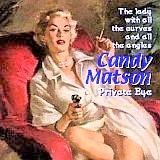
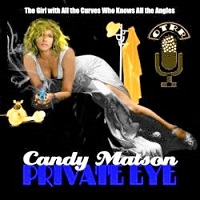 Candy Matson (1949-1951) aired “The Cable Car Case” on Thursday, July 7, 1949 as the 2nd of its estimated 92 shows (some accounts give 93 as the number, including a pilot that aired over a year later in hopes of sparking a revival that never took place). Candy Matson is a smart, self-sufficient, female detective. Everyone is familiar with all of the police or detective shows featuring a male detective, sleuth, or investigator (some in the superhero vein). There was The Saint, Sherlock Holmes, Nick Carter, Sam Spade, Philip Marlowe, Nero Wolfe, Jeff Regan (starring Jack Webb), Dragnet (again starring Jack Webb), Philo Vance, Johnny Dollar, The Green Hornet, The Shadow, and many, many others. One estimate runs to 120 OTR detective/police shows featuring a male lead. But not only were there Private Eyes on radio, there were Private Eyelashes as well, as early as the late 1930s and well into the 1940s (Kitty Keene, Carolyn Day-Detective, Miss Pinkerton, Meet Miss Sherlock, and Police Woman, to name a few). Though short lived (it never had a sponsor, advertisers were jumping on early television to promote their products), Candy Matson was one of the most popular radio shows west of the Mississippi and especially in San Francisco.
Candy Matson (1949-1951) aired “The Cable Car Case” on Thursday, July 7, 1949 as the 2nd of its estimated 92 shows (some accounts give 93 as the number, including a pilot that aired over a year later in hopes of sparking a revival that never took place). Candy Matson is a smart, self-sufficient, female detective. Everyone is familiar with all of the police or detective shows featuring a male detective, sleuth, or investigator (some in the superhero vein). There was The Saint, Sherlock Holmes, Nick Carter, Sam Spade, Philip Marlowe, Nero Wolfe, Jeff Regan (starring Jack Webb), Dragnet (again starring Jack Webb), Philo Vance, Johnny Dollar, The Green Hornet, The Shadow, and many, many others. One estimate runs to 120 OTR detective/police shows featuring a male lead. But not only were there Private Eyes on radio, there were Private Eyelashes as well, as early as the late 1930s and well into the 1940s (Kitty Keene, Carolyn Day-Detective, Miss Pinkerton, Meet Miss Sherlock, and Police Woman, to name a few). Though short lived (it never had a sponsor, advertisers were jumping on early television to promote their products), Candy Matson was one of the most popular radio shows west of the Mississippi and especially in San Francisco.
We have previously showcased but six of the 14 surviving Candy Matson episodes, the first back in March of 2017, two from 2018–August and December, one in January of 2021, and another in February of 2022, with the last coming in July of 2023, two years ago. For those not familiar with those widely spaced episodes and the show’s interesting history (a female detective, a veiled gay character, etc.), I am reprising below (with minor alterations) from the original introductory notes:
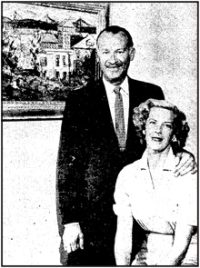 Candy Matson was the brainchild of Monty Masters. Originally conceived as a private investigator program set in San Francisco with a male lead, Masters’ mother-in-law convinced him to feature a female private eye. Masters then turned to his wife Natalie Masters (the former Natalie Park, 1915-1986: photo at left, Monty and Natalie, May 1957) to play the lead role, for which her real life personality was made. Candy Matson lived life to its fullest. A former actress who gave it all up for the life of a private detective, she now resides in a penthouse atop San Francisco’s famed Telegraph Hill. Throughout various episodes we learn that she loves her furs, sunbathing on her patio, listening to 49ers football games while sipping martinis, and pretty much her overall luxurious lifestyle. She never compromises in deference to her sexuality, and is a much sought after investigator–-as her high-end fees can attest. About her love of cash, Candy quips that it is needed to keep the “moths out of a few mink coats.” Candy had two recurring supporting characters in her adventures, handsome police Lieutenant Ray Mallard (with whom she has more than a professional relationship as the series progresses and as his character becomes more suave and alluring with each episode), and her best friend Rembrandt Watson, a single, middle-aged, flamboyant fashion photographer who enjoys the opera. Even though San Francisco had the largest gay community of any American city after World War II, and the show was set in the City by the Bay, network radio in the 40s and 50s would not allow an openly gay character to appear on the air, but Masters’s scripts managed to suggest as much, and the actor who played Watson, Jack Thomas (stage name for Natalie’s real life uncle), added a slightly feminine air to his characterization as time went on. After listening to almost all of the 14 extant episodes, it is easy to understand the popularity of Candy Matson. Natalie Masters plays her perfectly: saucy, sexy, smart, hard as nails when need be, and unapologetic and fully embracing her chosen lifestyle. A woman for the ages it would seem and ahead of her time. Natalie Masters would go on to have roles in several films and numerous episodes of popular tv shows, several of which are shown below.
Candy Matson was the brainchild of Monty Masters. Originally conceived as a private investigator program set in San Francisco with a male lead, Masters’ mother-in-law convinced him to feature a female private eye. Masters then turned to his wife Natalie Masters (the former Natalie Park, 1915-1986: photo at left, Monty and Natalie, May 1957) to play the lead role, for which her real life personality was made. Candy Matson lived life to its fullest. A former actress who gave it all up for the life of a private detective, she now resides in a penthouse atop San Francisco’s famed Telegraph Hill. Throughout various episodes we learn that she loves her furs, sunbathing on her patio, listening to 49ers football games while sipping martinis, and pretty much her overall luxurious lifestyle. She never compromises in deference to her sexuality, and is a much sought after investigator–-as her high-end fees can attest. About her love of cash, Candy quips that it is needed to keep the “moths out of a few mink coats.” Candy had two recurring supporting characters in her adventures, handsome police Lieutenant Ray Mallard (with whom she has more than a professional relationship as the series progresses and as his character becomes more suave and alluring with each episode), and her best friend Rembrandt Watson, a single, middle-aged, flamboyant fashion photographer who enjoys the opera. Even though San Francisco had the largest gay community of any American city after World War II, and the show was set in the City by the Bay, network radio in the 40s and 50s would not allow an openly gay character to appear on the air, but Masters’s scripts managed to suggest as much, and the actor who played Watson, Jack Thomas (stage name for Natalie’s real life uncle), added a slightly feminine air to his characterization as time went on. After listening to almost all of the 14 extant episodes, it is easy to understand the popularity of Candy Matson. Natalie Masters plays her perfectly: saucy, sexy, smart, hard as nails when need be, and unapologetic and fully embracing her chosen lifestyle. A woman for the ages it would seem and ahead of her time. Natalie Masters would go on to have roles in several films and numerous episodes of popular tv shows, several of which are shown below.
(Left: Dragnet, 1957 – Center: My Three Sons, 1964 – Right: The Addams Family, 1966–with Parley Bear, the voice of Chester on radio’s Gunsmoke and later as Mayor Stoner on tv’s The Andy Griffith Show.)
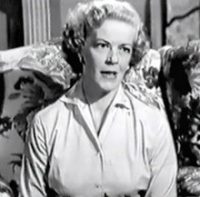
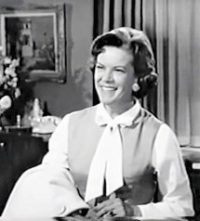
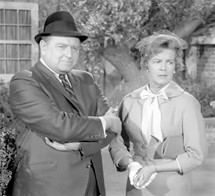
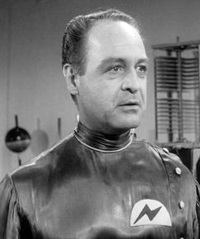 Dudley Manlove (1914-1996, photo at left), the program’s announcer, is an enigma, for no one knew of his whereabouts or circumstances until it was learned he had passed away in San Bernardino, CA from cirrhosis of the liver. Manlove married his second wife, the singer Patty Pritchard, in 1947. They were divorced in 1954. Little more is known of Pritchard following the divorce, though as of 2002 her voice could still be heard on a local San Francisco car dealer’s commercial. An interesting bit of trivia for science fiction genre fans is that Manlove played the alien named Eros from 1959’s Plan 9 from Outer Space. For TV he would guest-star in episodes of Dragnet and Alfred Hitchcock Presents.
Dudley Manlove (1914-1996, photo at left), the program’s announcer, is an enigma, for no one knew of his whereabouts or circumstances until it was learned he had passed away in San Bernardino, CA from cirrhosis of the liver. Manlove married his second wife, the singer Patty Pritchard, in 1947. They were divorced in 1954. Little more is known of Pritchard following the divorce, though as of 2002 her voice could still be heard on a local San Francisco car dealer’s commercial. An interesting bit of trivia for science fiction genre fans is that Manlove played the alien named Eros from 1959’s Plan 9 from Outer Space. For TV he would guest-star in episodes of Dragnet and Alfred Hitchcock Presents.
“The Cable Car Case” begins like other Candy Matson cases, with a phone call. This one differs right off the bat when, instead of someone seeking her services with a case to be solved, this one is from an unknown caller warning Candy to drop the case she has just undertaken on her own. An early scene has Candy riding one of San Francisco’s famous cable cars and sitting next to an obviously drunken passenger. When she turns to address him she finds him not passed out but dead, shot from afar by a sniper obviously using a silencer, for no sound of gunfire was heard above everyday background noises, including that of the cable car itself. Later, at home, when her growing romantic interest in the guise of police lieutenant Ray Mallard comes knocking on her door, it is in a professional capacity to question Candy due to her proximity to the dead man on the cable car, and to warn her against getting involved in a police matter. The story unfolds from there, with Candy of course ignoring lieutenant Mallard’s request that she stay out of this homicide investigation, instead oiling up her own investigatory machinery that will soon lead to a most unexpected murderer and the motive for the quiet crime in “The Cable Car Case.”
Play Time: 29:48
{Airing on Thursday, July 7th, shortly after July 4th, 1949 “The Cable Car Case” energized the neighborhood gang to head for the nearby newsstand the following morning looking for more fireworks from some of their favorite SF and Detective magazines. Fantastic Novels (1940-41, 1948-51) was begun at the request from numerous readers for classic SF and Fantasy novels before the time of the official genre magazines. Astute editor of Famous Fantastic Mysteries (1939-53) Mary Gnaedinger honored the requests by launching the novel counterpart to the pulp she already edited that featured the same reprint philosophy but at the shorter lengths. Both leaned heavily on such early favorites as A. Merritt, Ray Cummings, Austin Hall & Homer Eon Flint, and George Allen England, performing a valuable service for early fans of the fantastic. It was a bimonthly in 1949. Super Science Stories (1940-43, 1949-51) featured a mix of the earliest SF pulp authors with more that would be making names for themselves in the years to come. The stories were plot and action oriented and full of color and adventure, though predictably light on scientific accuracy (though readers didn’t know or care). A few of the older as well as the newer popular writers included Cleve Cartmill, Arthur Leo Zagat, Ray Cummings, Isaac Asimov, Ray Bradbury, and Henry Kuttner. Though a bimonthly it managed only 5 issues in 1949. Triple Detective (1947-55) was a godsend for mystery and detective fans who enjoyed hunkering down for more than a few minutes with the short stories offered in detective pulps and losing themselves in full length novels. Three whole novels for a mere 35 cents was an offer they couldn’t refuse. It was a quarterly throughout its run.}
[Left: Fantastic Novels, 7/49 – Center: Super Science, 7/49 – Right: Triple Detective, Summer/49]
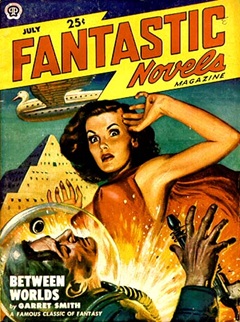
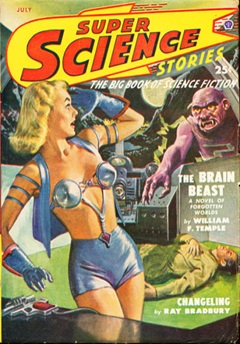
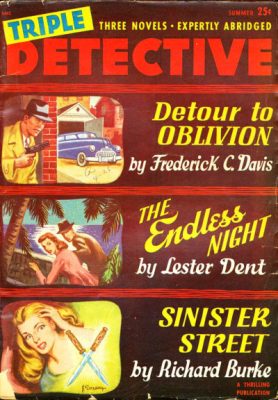
To view the entire list of weekly Old Time Radio episodes at Tangent Online, click here.